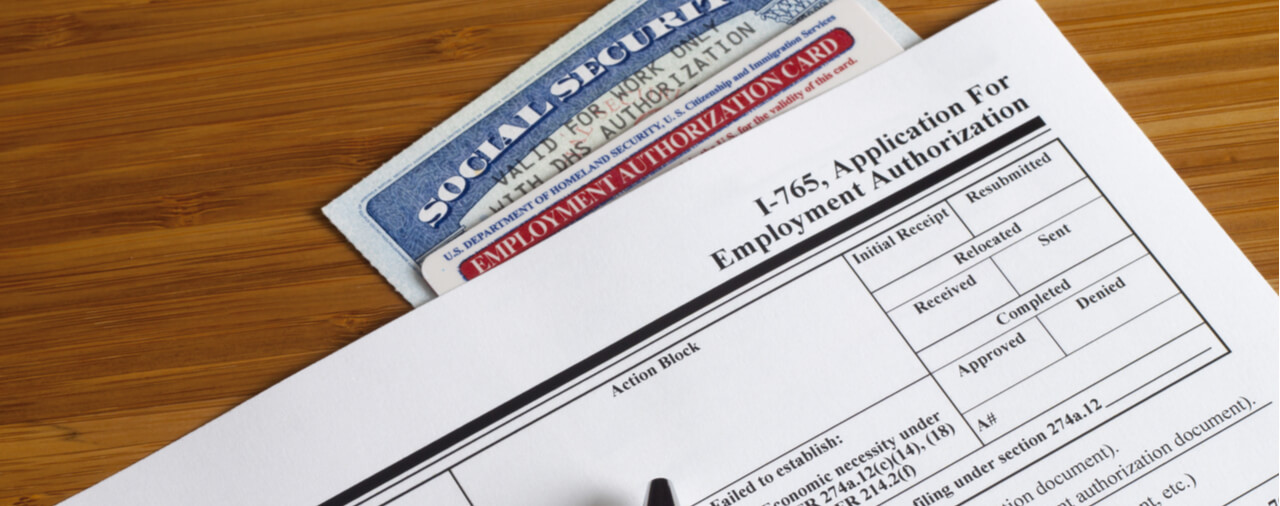- Introduction
- Who Is Eligible For the Automatic EAD Extension?
- Effect On Aliens With Expired 180-Day Extensions
- End of Extension
- Temporary Change?
- Conclusion
Introduction
Beginning on January 17, 2017, the United States Citizenship and Immigration Services (USCIS) began granting automatic 180-day extensions of employment authorization documents for aliens applying to renew their employment authorization documents in certain categories Effective May 4, 2022, the USCIS tripled the automatic 180-day extension, extending it to 540 days. The 540-day rule is temporary, and is slated to expire on October 27, 2023, at which time the automatic extension period for new renewal applications will revert to 180 days.
USCIS Press Release: Link
Interim Rule: Link
The new 540-day automatic extension will apply in the case cases and circumstances that the previous 180-day extension did. We will explain in detail how the 540-day automatic EAD extension for certain categories works and who exactly is covered.
We previously wrote about the 180-day extension in detail [see article]. The rules described in our original article apply in full save for the fact that the 180-day extension period has been temporarily extended to 540 days (we appended an update to the original article). Below, we will explain the cases and circumstances that benefit from the 540-day extension. We will conclude by addressing the fact that the 540-day extension is being presented as a temporary policy, meaning that the USCIS may revert to the former 180-day extension rules in the future.
Who Is Eligible For the Automatic EAD Extension?
The automatic 540-day EAD extension only applies in specific cases and circumstances.
Firstly, the alien must have a properly filed Form I-765 for a renewal of his or her employment authorization or EAD before the previous employment authorization or EAD expires.
It is important to note that not just any application for employment authorization/EAD renewal qualifies for the automatic 540-day extension. The extension request must be in a specific category that is covered by the former 180-day, current 540-day, rule. This means:
1. The renewal application must be in a qualifying category
2. The category on the alien’s current EAD matches the “Class Requested” on the alien’s Form I-797C Notice of Action.
(Note in TPS cases: TPS beneficiaries or pending TPS applicants must have an EAD and Form I-797C Notice of Action containing either the A12 or C19 category, but the categories do not need to match each other.)
(Note in H4, E, and L2 dependent spouse cases: The alien must have an unexpired Form I-94 indicating H4, E, or L2 nonimmigrant status along with the Form I-797C).
Below, you will find a list of the EAD categories that qualify for the automatic 540-day extension.
| Eligibility Category Listed on Form I-765 | Description |
| (a)(3) | Refugee |
| (a)(5) | Asylee |
| (a)(7) | N-8 or N-9 |
| (a)(8) | Citizen of Micronesia, Marshall Islands, or Palau |
| (a)(10) | Withholding of Deportation or Removal Granted |
| (a)(12) | Temporary Protected Status (TPS) granted |
| (a)(17) | Spouse of principal E nonimmigrant with unexpired I-94 showing E nonimmigrant status |
| (a)(18) | Spouse of principal L-1 Nonimmigrant with an unexpired I-94 showing L-2 nonimmigrant status |
| (c)(8) | Asylum Application Pending |
| (c)(9) | Pending Adjustment of Status under Section 245 of the Act |
| (c)(10) | Suspension of Deportation Applicants (filed before April 1, 1997); Cancellation of Removal Applicants; Special Rule Cancellation of Removal Applicants Under NACARA |
| (c)(16) | Creation of Record (Adjustment Based on Continuous Residence Since January 1, 1972) |
| (c)(19) | Pending initial application for TPS where USCIS determines applicant is prima facie eligibl;e for TPS and can receive an EAD as a “teporary treatment benefit” |
| (c)(20) | Section 210 Legalization (pending I-700) |
| (c)(22) | Section 245A Legalization (pending I-687) |
| (c)(24) | LIFE Legalization |
| (c)(26) | Spouses of certain H-1B principal nonimmigrants with an unexpired I-94 showing H-4 nonimmigrant status |
| (c)(31) | VAWA Self-Petitioners |
We covered this guidance and additional issues relating to the 540-day extension in our original article on the 180-day extension [see section]. That guidance is still pertinent with the provision that the extension period is now 540 days instead of 180 days.
Effect On Aliens With Expired 180-Day Extensions
The rule will benefit certain aliens who received 180-day extensions that lapsed. From the USCIS news release:
Noncitizens with a pending EAD renewal application whose 180-day automatic extension has lapsed and whose EAD has expired will be granted an additional period of employment authorization and EAD validity, beginning on May 4, 2022 and lasting up to 540 days from the expiration date of their EAD, such that they may resume employment if they are still within the up to 540-day automatic extension period and are otherwise eligible.
Thus, if an alien is in the 180-extension period as of May 4, 2022, his or her employment authorization will be extended for up to an additional 360 days, such that the total extension is 540 days. If an alien has a pending EAD application as of May 4, 2022, that has been pending for more than 180 days, such that his or her 180-day extension expired, will be granted an additional period such that the total extension is 540 days from the original expiration of their EAD.
End of Extension
The 540-day extension functions identically to the 180-day extension in all respects other than length. The automatic 540-day EAD extension “generally will end upon notification of a final decision on the renewal application or the end of the up to 540-day period …, whichever comes earlier.”
Temporary Change?
The USCIS has indicated that the shift from the 180 extension to the new 540-day extension is temporary. See the following passage from the USCIS news release:
The TFR, which only applies to those EAD categories currently eligible for an automatic up to 180-day extension, will temporarily provide up to 360 days of additional automatic extension time (for a total of up to 540 days) to eligible applicants with a timely-filed Form I-765 renewal application pending during the 18-month period after publication of the TFR while USCIS continues to work through pending caseloads that were exacerbated by the COVID-19 pandemic. This timeframe will allow USCIS an opportunity to address staffing shortages, implement additional efficiencies, and meet Director Jaddou’s recently announced goal of achieving a three-month cycle time for EAD applications (generally comparable to a median three-month processing time) by the end of FY23. Beginning Oct. 27, 2023, automatic extensions of employment authorization and EAD validity will revert to the up to 180-day period for those eligible applicants who timely file Form I-765 renewal applications.
Thus, as of now, the USCIS plans to return to the permanent 180-day extension rule beginning on October 27, 2023. In the interim, however, extensions will be 540 days.
Conclusion
The USCIS states that the purpose of temporarily changing the automatic 180-day Employment Authorization Documents extension rule to 540-days stems from administrative issues beginning with the onset of the 2020 coronavirus pandemic. However, regardless of the cause, it will benefit qualifying individuals who would have otherwise been granted automatic 180-day EAD extensions, ensuring that they will be authorized to work even if their EAD renewal requests remain pending for longer than 180 days.
Individuals with case-specific questions, including how the rule does or does not apply to their particular cases, should consult with an experienced immigration attorney for case-specific guidance.





